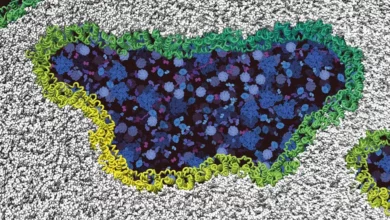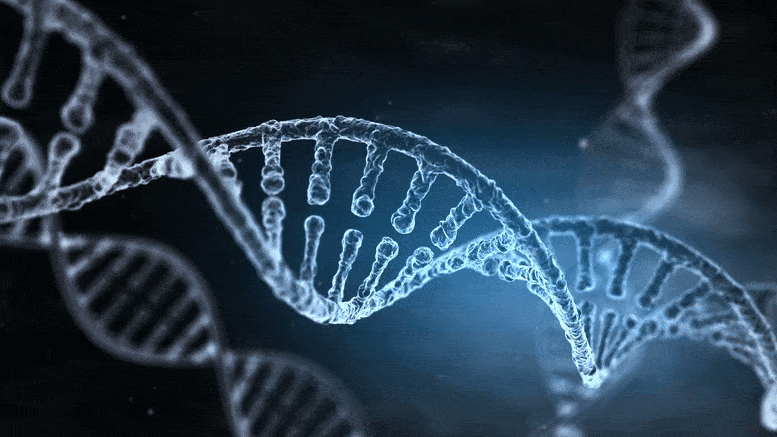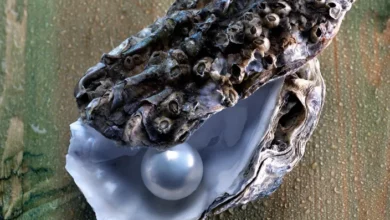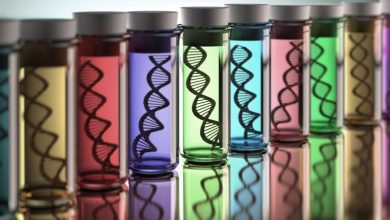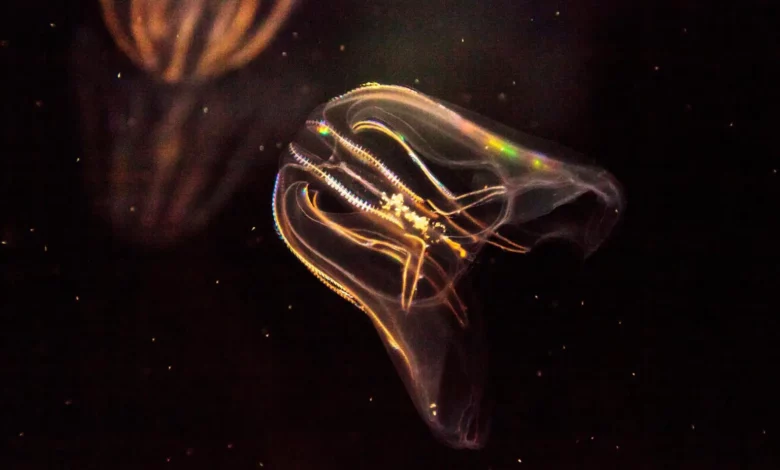
Lead Image: A study by MBARI and collaborating scientists used gene linkages to establish that comb jellies, not sponges, are the most distantly related animal to all other animals, helping to clarify a fundamental question about animal evolution that dates back over 700 million years.
Mapping gene linkages provides clear-cut evidence for comb jellies as sibling group to all other animals.
A groundbreaking study published in Nature by MBARI researchers and their collaborators offers fresh insights into the earliest points of animal evolution, tracing back over 700 million years. The study revolves around the mystery of which animal, sponges or comb jellies (ctenophores), represents the most distant relation to all other animals. By mapping sets of genes found together on a single chromosome across a wide array of animals, the researchers presented strong evidence that comb jellies form the sibling group to all other animals.
A study published by MBARI researchers and their collaborators today (May 17) in Nature provides new insights about one of the earliest points in animal evolution that happened more than 700 million years ago.
For more than a century, scientists have been working to understand the pivotal moment when an ancient organism gave rise to the diverse array of animals in the world today. As technology and science have advanced, scientists have investigated two alternative hypotheses for which animals—sponges or comb jellies, also known as ctenophores—were most distantly related to all other animals. Identifying this outlier—known as the sibling group—has long eluded scientists.
In the new study, a team of researchers from MBARI, the University of California, Berkeley, the University of California, Santa Cruz, and the University of Vienna mapped sets of genes that are always found together on a single chromosome, in everything from humans and hamsters to crabs and corals, to provide clear evidence that comb jellies are the sibling group to all other animals. Understanding the relationships among animals will help shape our thinking about how key features of animal anatomy, such as the nervous system or digestive tract, have evolved over time.
“We developed a new way to take one of the deepest glimpses possible into the origins of animal life. We’ve used genetics to travel back in time about one billion years to get the strongest evidence yet to answer a fundamental question about the earliest events in animal evolution,” said Darrin Schultz, previously a graduate student researcher at MBARI and UC Santa Cruz and now a postdoctoral researcher at the University of Vienna. “This finding will lay the foundation for the scientific community to begin to develop a better understanding of how animals—and humans—have evolved.”
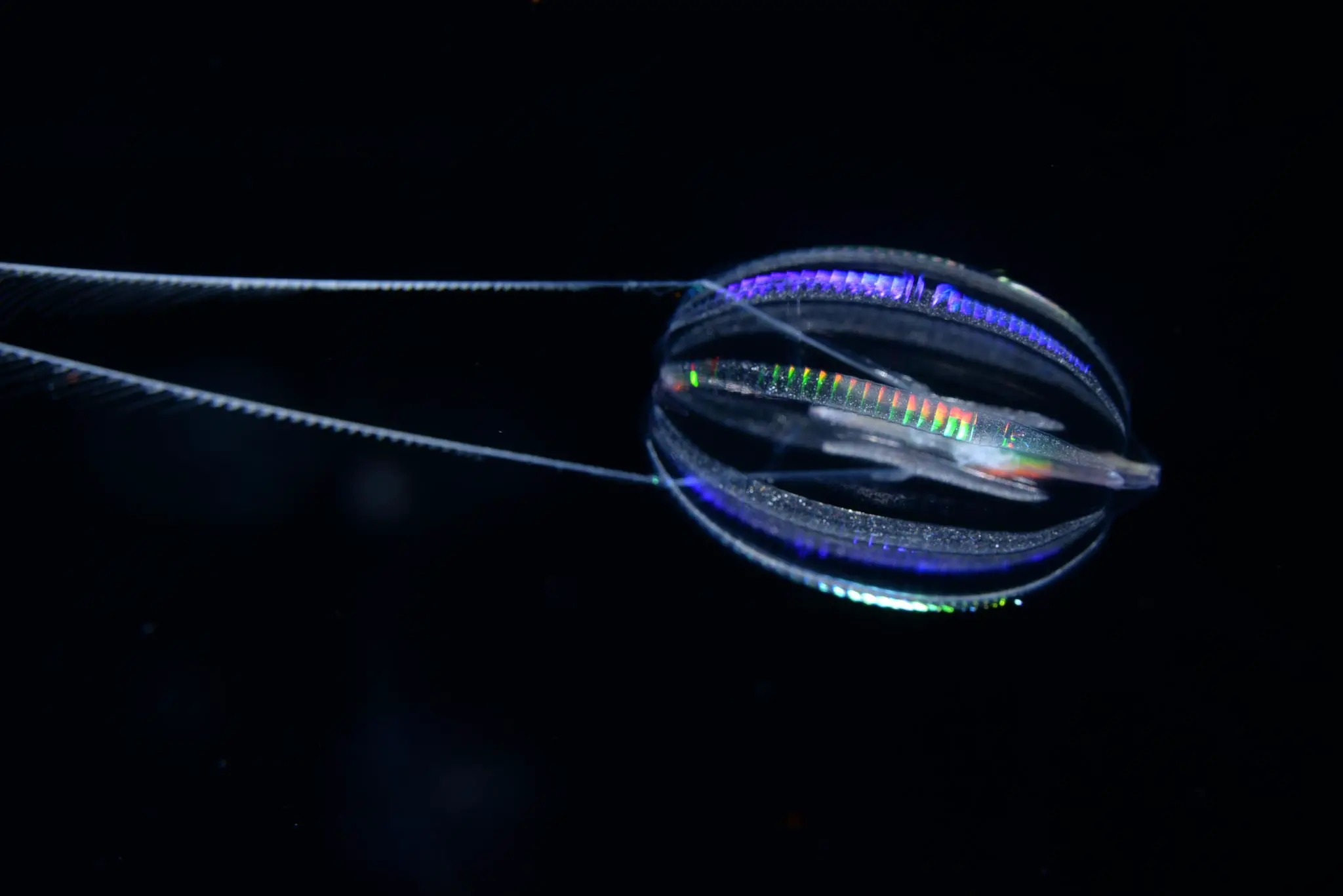
All of the genes in an animal are organized in sequences on chromosomes. The location of an individual gene sequence can change over time, but changes to the linkages between genes on a particular chromosome are rare and largely irreversible.
Until now, scientists have only looked at the similarities in the sequencing of individual genes to answer long-standing questions about the most ancient animal relationships.
Schultz and team examined the linkages between genes on specific chromosomes, which are deeply conserved throughout time. They identified patterns that exist in a variety of animals and mapped those linkages back to the earliest point in animal evolution. The team found strong evidence that comb jellies represent a unique lineage whose ancestors diverged before the common ancestor of all other animals.
The team compares this event to a genetic fork in the road of evolution that happened hundreds of millions of years ago. One lone single-celled organism, the ancestor of all animals, was traveling along that road with its two offspring. One child, which would evolve into comb jellies as we know them today, took one path. As it evolved, the genes on its chromosomes stayed in a specific order and did not change much. The other child, which would evolve into sponges and all other animals as we know them today, took the other path. Many of the genes on its chromosomes rearranged themselves and fused together. Because these rearrangements are irreversible and passed down generation to generation, they are detectable even today. By tracking these rearrangements, the team found clear-cut evidence that comb jellies, not sponges, are the sibling group to all other animals.
“The fingerprints of this ancient evolutionary event are still present in the genomes of animals hundreds of millions of years later,” said Schultz. “This research helps strengthen the foundation of our understanding of the genetics of animal life. It gives us context for understanding what makes animals animals. This work will help us understand the basic functions we all share, like how they sense their surroundings, how they eat, and how they move.”
Background
More than 700 million years ago, different groups of small organisms split off the tree of life to evolve along their own independent paths, becoming the animals we know today.
Researchers began working to understand the relationships between animals more than a century ago, and for most of this time period, they assumed that sponges split off the tree of life hundreds of millions of years ago making them the sibling group to all other animals.
However, 15 years ago, researchers were able to use new DNA-sequencing technologies to find the first evidence that ctenophores, not sponges, were the sibling group of all other animals. This research sparked a great effort by the scientific community to develop new ways to confirm the identity of the oldest branch of the animal family tree, but a definitive answer remained unclear.
While groups of animals have evolved hundreds of millions of years apart, a remarkably large number of genes remain linked to the same chromosomes across these vastly different groups. Over time, the sequence of genes on each chromosome may change, but the actual link to the chromosome remains the same, except for in rare circumstances. Researchers have historically compared the gene sequences that coded for key proteins to infer how groups of organisms are related to one another. However, they found that this technique did not give reliable answers about whether sponges or ctenophores were the sibling group of all other animals.
MBARI researchers used a novel technique to find new clues in the genomes of comb jellies and sponges.
First, Schultz and the team sequenced the genomes for the entire length of each chromosome for two comb jellies and two marine sponges as well as three single-celled close relatives of animals—a choanoflagellate, a filasterean amoeba, and an ichthyosporean—in order to create a more complete and organized picture of each one’s genes.
With the complete chromosome sequences in hand, MBARI researchers looked for patterns of linked genes to help answer the question of whether sponges or ctenophores are the most distant relative of all other animals.
Because links between genes and chromosome location change relatively slowly, these changes reveal how ancient genomes may have been arranged. Distinct, rare changes and conserved patterns can be used to unambiguously unite all descendant lineages. This can help resolve long-standing questions about animal relationships.
When they examined the chromosome-scale genome of comb jellies, they saw a grouping of genes that was very different from the patterns in other animals. Most importantly, they found patterns of genes that were shared between the ctenophores and three single-celled non-animals, whereas those patterns have been shuffled and mixed in all other animals, from sponges to sparrows.
Comparing specific patterns of linked genes allowed researchers to build a deeply-rooted tree of animal life and better establish the order in which branches split off from the main trunk.
The team uses two decks of cards—one blue and one yellow—as an analogy for how these gene linkages work.
The blue and yellow cards in each deck are separate and represent genes on distinct chromosomes. First, the two decks merge, representing chromosome fusion events. Then, shuffling the decks further is like swapping genes between chromosomes. Each shuffle yields an increasingly small chance that you could cut the deck and have all blue cards in one half and all yellow cards in the other. Likewise, following patterns of genes across the tree of animal life, there would be an increasingly small chance that gene linkages from ancestral organisms would be reproduced by chance in the furthest branches of the tree.
Reference: “Ancient gene linkages support ctenophores as sister to other animals” 17 May 2023, Nature.
DOI: 10.1038/s41586-023-05936-6
Funding for this research was provided by the David and Lucile Packard Foundation, MBARI, the National Science Foundation (GRFP DGE 1339067 and DEB-1542679), the European Research Council’s Horizon 2020: European Union Research and Innovation Programme (grant No. 945026), internal funds of the Okinawa Institute of Science and Technology Molecular Genetics Unit, the Chan Zuckerberg Biohub Network, and the Marthella Foskett Brown Chair in Biological Sciences.

